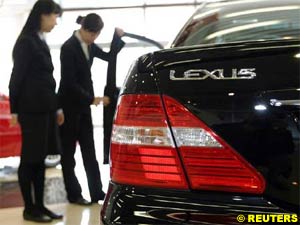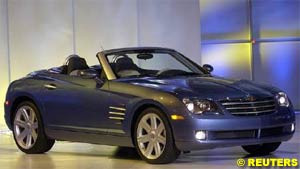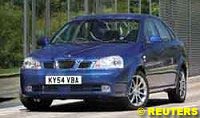

Automotive News and Reviews for the Petrolhead
In this week's issue:
- Toyota Profits Jump on Strong Sales
- Automakers Build Eye-Catching Cars
- Car Briefs
Toyota has posted a 32 percent jump in quarterly operating profit after strong sales overseas helped the maker of the Lexus, Camry and Prius hybrid cars offset losses from a weaker dollar.
Analysts expect the world's second-biggest car maker to keep profits at last year's record levels in 2004/2005 as it rolls out a steady stream of new products in every region.
That includes adding more hybrid-powered vehicles, which switch between gasoline and electric power, in the key U.S. market.
Sales for the Toyota brand at home fell slightly during the first six months, but group-wide sales rose 1.1 percent, better than the overall market thanks to growth at minicar unit Daihatsu Motor Co and truck maker Hino Motors.
Operating profit at Toyota, the world's most valuable auto maker with a market capitalisation of $143.5 billion (78.7 billion pounds), was 448.62 billion yen (2.22 billion pounds) for the first quarter ended June 30, compared with 340.77 billion yen in the year earlier period. Net profit rose 29 percent to 286.62 billion yen.
Sales climbed 10.2 percent to 4.510 trillion yen.
Toyota, which last year overtook Ford as the world's biggest car seller behind General Motors, is cruising ahead of rivals thanks to an abundance of new products, cutting-edge technology and cost-cutting expertise.
Last business year, Toyota earned about $1,570 for every car it sold, compared with around $440 for GM.
First-quarter earnings were hit by a 9 yen fall in the dollar to around 110 yen, but the exchange rate was still better than Toyota's 105 yen assumption for the year to March 2005. Toyota kept its exchange rate assumptions unchanged for the year, expecting the euro to average 125 yen.
Firm overseas sales also helped Japanese rivals Nissan and Honda raise profits in the quarter, but their growth lagged Toyota's.
Given the rapid sales growth abroad, Toyota raised its 2004/05 group global sales forecast by 2.6 percent to 7.2 million vehicles. Both Daihatsu and Hino Motors are picking up sales in the wake of a freefall in demand at Mitsubishi Motors, which has been mired in a recall scandal.
Japan's only loss-making car maker, which saw car sales plunge by more than 50 percent for the third straight month in July, reports quarterly results on Wednesday.
Toyota shares outperformed rivals during the quarter, putting on 14 percent to 4,420 yen. That compared with a rise of 10 percent for Honda and 4 percent for Nissan.
On Tuesday, they ended down 1.35 percent at 4,370 yen before the results were announced.
Written by Chang-Ran Kim, Asia auto correspondent
Think the head-turning, low-slung Chrysler Crossfire sports car or the curvy, retro-style Chevrolet SSR pickup are built by Detroit automakers? Think again.
Mass market automakers, to compete in a crowded arena, increasingly are turning to small "coachbuilders" or engineering firms for help with distinctive low-volume vehicles that can strengthen a brand's image far beyond their sales numbers.
"We have to break some manufacturing rules to get some of these cool (design) proportions to appear," Larry Achram, vice president of virtual engineering on the Chrysler Crossfire, told Reuters. "If it's a niche vehicle, and you don't have to build it in your own house, it's much less expensive."
Coachbuilders - a term left over from the horse-drawn carriage makers of a century ago - are common all over Europe particularly for building a one-off show car.
But industry officials see an opportunity for small companies to take a greater role in building production cars in North America, despite the overcapacity in the auto industry created by underutilized plants.
Coachbuilders are able to design, engineer or build a vehicle in half the time of a mass-market company, saving hundreds of millions of dollars, and absorbing much of the risk associated with any new car or truck launch, executives said.
Car designs, like fashion, appeal to the emotions, and automakers must strike quickly with a hit show vehicle before trends change.
"These things age. The ability to be very agile and fast is the key to success," said Mark Reuss, executive director of General Motors' performance division.
Ground-Breaking
Investment by the niche manufacturers in assembly plants and expensive tooling machinery frees up capital for automakers to invest in future development of cars and trucks.
"It gives (car companies) opportunities to take things off the balance sheet, because all the tools are taken on by suppliers," said Tim Olind, chief operating officer of Karmann USA, a unit of Germany's Wilhelm Karmann.
Karmann, which builds the Crossfire as well as the Audi A4 and Mercedes CLK convertibles in Germany, broke ground in July for a 144,000 square-foot facility in Plymouth, Michigan, to engineer and eventually build cars, Olind said.
One of the first cars the facility will work on will be GM's Pontiac G6 convertible. The first mass-market retractable hardtop car to be built in North America in years, it goes into production in 2005.
With the car market fragmenting and consumers demanding more choices, the number of nameplates, or individual vehicles, in the United States has grown well past 300, from about 250 four years ago. The average sales volume per nameplate, excluding pickup trucks, has dropped to around 40,000, from more than 100,000 15 years ago.
That creates opportunities for some specialists.
Canadian auto parts company Magna International, which also builds the BMW X3 sport utility vehicle and DaimlerChrysler's Jeep Liberty SUV at its Magna Steyr plant in Austria, has said it could add an assembly plant in North America.
Magna would consider building a new facility or taking over an existing assembly plant from a down-sizing automaker, a spokesman said.
Hot Concept
The Chevrolet SSR, a pickup/roadster crossover, would be just another show car without ASC Inc., which changed its name from American Sunroof Company to American Specialty Cars earlier this year as the engineering and design company expanded the scope of its work.
The SSR was a big hit when it was unveiled as a concept at the Detroit auto show in 2000, but GM had difficulty figuring out how to build the low-volume truck profitably.
"The SSR was named dead in the water in GM internally, from a financial standpoint," said Jeff Steiner, ASC executive vice president and chief marketing officer.
ASC's solution was to build a plant in Lansing, Michigan, to assemble 42 major SSR subcomponents, including the instrument panel and retractable roof. ASC cut costs by using some obsolete equipment, a less-sophisticated production line, and more manual labor than an average high-tech assembly plant.
Virtually the entire SSR passes through the ASC plant before it is shipped nearly five miles to a previously underutilized GM plant for final assembly.
Both the SSR and the Crossfire are making profits for the carmakers, executives said.
"We wouldn't have gotten the car if we had not done it that way," GM's Reuss said. "We really hadn't done anything like that before."
Written by Michael Ellis
New Off-Roaders from Subaru and Mercedes
The latest Mercedes off-roader is also nearing production. The MLG will replace the indestructible G-Wagen, favoured transport of European armies (amusingly, the French army have the Mercedes G-Wagen rebadged as a Peugeot, so as to maintain Gallic pride). The new car will be based on the ML (about the least indestructible car Mercedes has ever made), although it will be the next generation ML. Military types will want to know with which parent it has most in common.
Daewoo Nubira Special Offer
The price of £11,995 includes Daewoo's Peace of Mind package, with 3-years'/60,000 miles free servicing, 3-years'/60,000 mile warranty and 3-years' Total AA Roadside Assistance.
As an incentive across the range, Daewoo is also offering a free home DVD player to anyone who test drives a Daewoo before the end of August and goes on to purchase a new car - regardless of whether it's a Daewoo or another manufacturer's vehicle.
Next Generation Fuel Cell Honda
At the moment each fuel cell prototype costs hundreds of thousands of dollars. There is no word yet on what a mass-produced fuel cell car would cost to make, but it would be significantly more than any comparable petrol or diesel model. However, Honda says that they have reduced the component count by 50% and are working hard on making fuel cells cost-competitive. A hydrogen-powered fuel cell car is still probably a decade away, though.
New Mazda MX-5 special edition
There is a choice of three exterior colours: Razor Blue metallic, unique to Mazda MX-5 Arctic, as well as Titanium Grey and Sunlight Silver.
In addition a detachable hardtop is being offered on the MX-5 for £1,000 (normally £1,450) until the end of September.
Written by Verdict On Cars
![]() Toyota Profits Jump on Strong Sales
Toyota Profits Jump on Strong Sales
 Toyota's sales in the Unites States have risen in each of the last 14 months year-on-year, and it shipped over 1 million units in the first half.
Toyota's sales in the Unites States have risen in each of the last 14 months year-on-year, and it shipped over 1 million units in the first half.
![]() Automakers Build Eye-Catching Cars
Automakers Build Eye-Catching Cars
 Major car companies are geared to build upwards of 100,000 of a particular model annually. Adding a vehicle such as a sports car, which sells in much smaller numbers, to an assembly line can be costly and severely disrupt the production process, executives said.
Major car companies are geared to build upwards of 100,000 of a particular model annually. Adding a vehicle such as a sports car, which sells in much smaller numbers, to an assembly line can be costly and severely disrupt the production process, executives said.
![]() Car Briefs
Car Briefs
 Prototypes of a new Subaru, the Tribeca, have been spotted undergoing testing. The Tribeca is a seven seat 4x4, a bit bigger than a Legacy Outback, the car it will eventually replace. The Tribeca will also spawn a new Saab, the 9-6X, which will be almost identical. However, the Saab version needs to include a diesel engine, which is causing the engineers some headaches. All Subarus are designed around a horizontally opposed four-cylinder engine (a so-called "flat four"), mounted lengthways. As there is no such thing as a flat four diesel, the engine bay will have to accommodate both a longitudinal petrol engine and a transverse diesel one.
Prototypes of a new Subaru, the Tribeca, have been spotted undergoing testing. The Tribeca is a seven seat 4x4, a bit bigger than a Legacy Outback, the car it will eventually replace. The Tribeca will also spawn a new Saab, the 9-6X, which will be almost identical. However, the Saab version needs to include a diesel engine, which is causing the engineers some headaches. All Subarus are designed around a horizontally opposed four-cylinder engine (a so-called "flat four"), mounted lengthways. As there is no such thing as a flat four diesel, the engine bay will have to accommodate both a longitudinal petrol engine and a transverse diesel one.
 Daewoo is offering free leather and satellite navigation on its Nubira 1800 CDX model up to 30 September 2004. This is in addition to the standard features including climate control, front and side airbags, CD player and rain-sensing windscreen wipers.
Daewoo is offering free leather and satellite navigation on its Nubira 1800 CDX model up to 30 September 2004. This is in addition to the standard features including climate control, front and side airbags, CD player and rain-sensing windscreen wipers.
 Honda in the USA has announced details of its second-generation fuel cell vehicle (FCV). The raw numbers suggest that performance of fuel cell cars is now approaching that of petrol ones. Power is up 33% to 107 bhp and economy is also up 20% to 57 mpkg (that is not a misprint: hydrogen is measured in kilograms, not litres, but the two are roughly comparable as a measure of efficiency). Of course, the good news is that there are no emissions at all unless (you count water vapour), but the bad news is the cost.
Honda in the USA has announced details of its second-generation fuel cell vehicle (FCV). The raw numbers suggest that performance of fuel cell cars is now approaching that of petrol ones. Power is up 33% to 107 bhp and economy is also up 20% to 57 mpkg (that is not a misprint: hydrogen is measured in kilograms, not litres, but the two are roughly comparable as a measure of efficiency). Of course, the good news is that there are no emissions at all unless (you count water vapour), but the bad news is the cost.
 Mazda has introduced the special edition MX-5 Arctic, priced from £17,000 for the 1600cc and £17,500 for the 1800cc model. Additional equipment includes air conditioning, heated leather seats, leather trimmed steering wheel, gear knob and handbrake lever plus 15" alloy wheels.
Mazda has introduced the special edition MX-5 Arctic, priced from £17,000 for the 1600cc and £17,500 for the 1800cc model. Additional equipment includes air conditioning, heated leather seats, leather trimmed steering wheel, gear knob and handbrake lever plus 15" alloy wheels.
| Contact the Editor |
© 2007 autosport.com . This service is provided under the Atlas F1 terms and conditions.
|
Volume 10, Issue 31
Atlas F1 Special
The Stars Align
Boy Wonder
In Search of the Holy Grail
Chemistry Cocktail
The Conservative Party
The Reshuffle: Facts & Stats
The Reshuffle Trivia Quiz
Columns
On The Road
Elsewhere in Racing
The Weekly Grapevine
> Homepage |